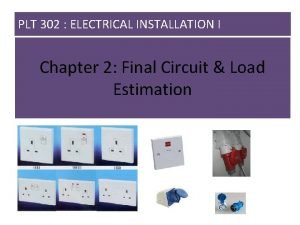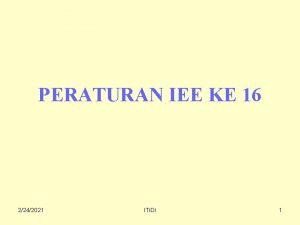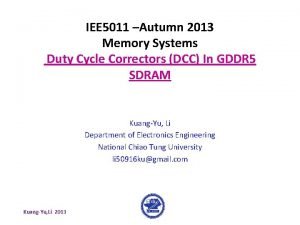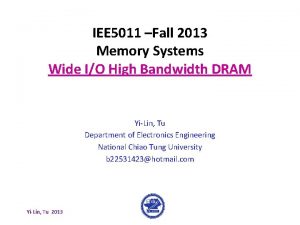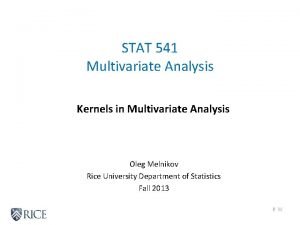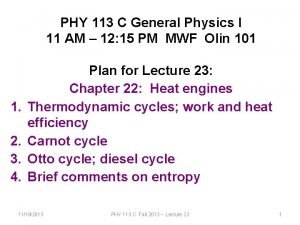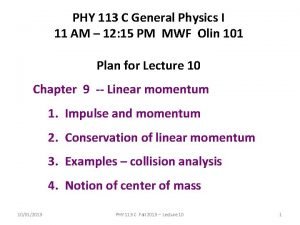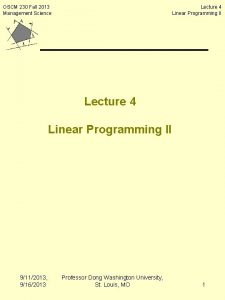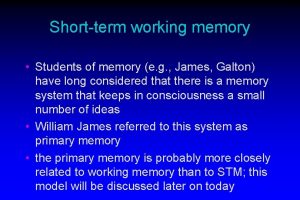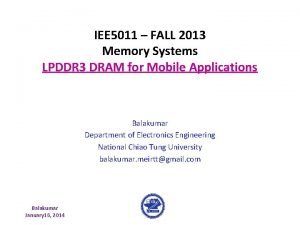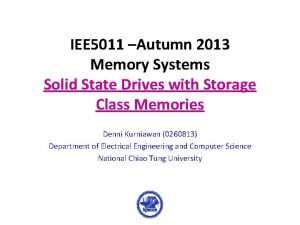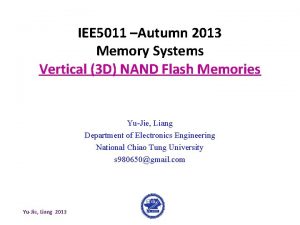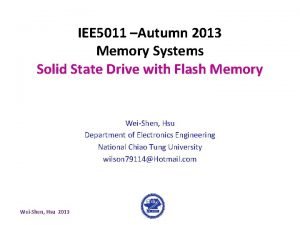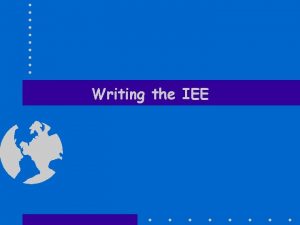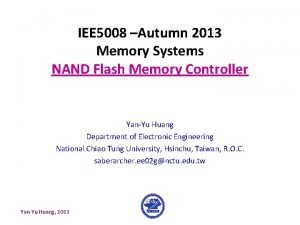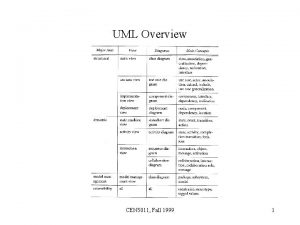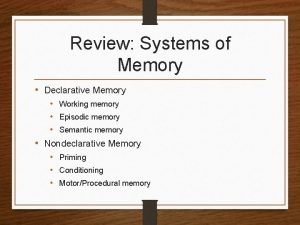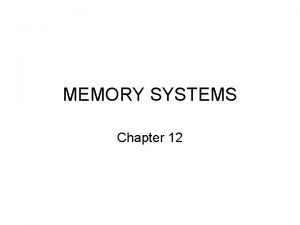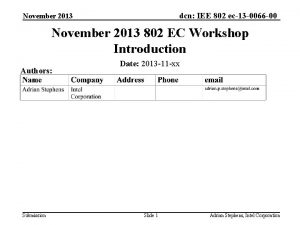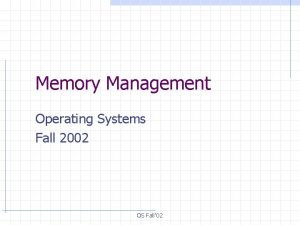IEE 5011 Fall 2013 Memory Systems Wide IO

























- Slides: 25

IEE 5011 –Fall 2013 Memory Systems Wide I/O High Bandwidth DRAM Yi-Lin, Tu Department of Electronics Engineering National Chiao Tung University b 22531423@hotmail. com Yi-Lin, Tu 2013

Outline n Introduction n Proximity Communication n A Wide I/O DRAM Architecture n Conclusion n Reference Yi-Lin, Tu NCTU IEE 5011 Memory Systems 2013 2

Introduction n Memory gap n How to solve this problem? n Other techniques? Yi-Lin, Tu NCTU IEE 5011 Memory Systems 2013 3

Proximity Communication n A wireless chip-to-chip communication technology. n Two chips are placed face to face and their bonding pads are allowed to come within close proximity of each other without touching. Yi-Lin, Tu NCTU IEE 5011 Memory Systems 2013 4

Proximity Communication Yi-Lin, Tu NCTU IEE 5011 Memory Systems 2013 5

Proximity Communication n Advantages l Increase I/O density l Remove the on/off chip wires l Remove the on-die termination l Ease of testability l Remove the ESD structures Yi-Lin, Tu NCTU IEE 5011 Memory Systems 2013 6

Proximity Communication n Yi-Lin, Tu NCTU IEE 5011 Memory Systems 2013 7

Proximity Communication n Challenges l Mechanical misalignment l Supplying power to chips l Thermal removal Yi-Lin, Tu NCTU IEE 5011 Memory Systems 2013 8

Proximity Communication n Mechanical misalignment l Six axis l Multiple source Yi-Lin, Tu NCTU IEE 5011 Memory Systems 2013 9

Proximity Communication n Electronic sensor l Chip to chip separation sensor l Vernier scale(translation) Yi-Lin, Tu NCTU IEE 5011 Memory Systems 2013 10

Proximity Communication n Electronic re-alignment l Use receiver and transmitter array. l This array has the ability to electrically reposition the transmitter pads to align the transmitter and receiver pads. Yi-Lin, Tu NCTU IEE 5011 Memory Systems 2013 11

A Wide I/O DRAM Architecture n Using 4 Gb DRAM as the starting point for developing a wide I/O DRAM architecture. Yi-Lin, Tu NCTU IEE 5011 Memory Systems 2013 12

A Wide I/O DRAM Architecture n Pad moving l Moving the I/O channel to the edge. l Data and comment signals will need to be buffered at the center. l Allows the local column circuitry to be moved to the center. Yi-Lin, Tu NCTU IEE 5011 Memory Systems 2013 13

A Wide I/O DRAM Architecture n Centralizing l Limit the bandwidth of the column and row path. l It’s possible by using proximity communication. l Increase the array efficiency. Yi-Lin, Tu NCTU IEE 5011 Memory Systems 2013 14

A Wide I/O DRAM Architecture n Conventional DRAM chips operate with eight internal memory bank. n Enable eight wordlines to be active at once, one of each bank. n Possible to perform sequential column access to each bank. n Remove the large row access latency. Yi-Lin, Tu NCTU IEE 5011 Memory Systems 2013 15

A Wide I/O DRAM Architecture n 512 Mb bank structure l 4 possible arrangements for creating a 512 Mb memory bank. l Keep the global I/O metal lines short allows for a higher bandwidth on an open page. l C and D are preferred. Yi-Lin, Tu NCTU IEE 5011 Memory Systems 2013 16

A Wide I/O DRAM Architecture Yi-Lin, Tu NCTU IEE 5011 Memory Systems 2013 17

A Wide I/O DRAM Architecture n Challenges l Number of metal layers l Global I/O routing l Local I/O routing Yi-Lin, Tu NCTU IEE 5011 Memory Systems 2013 18

A Wide I/O DRAM Architecture n Number of metal layers and global I/O routing l A wide I/O architecture with 64 data pins operating with burst length of eight, and therefore a pre-fetch of 8 n, requires 512 bits to be accessed in parallel. l The highest level of metal is used for global I/O routing and metal one is for global wordlines. l Increase the parasitic of each wordline. Yi-Lin, Tu NCTU IEE 5011 Memory Systems 2013 19

A Wide I/O DRAM Architecture n Divide the 8 k page l 256 bits per half-bank l This enables a possibility of increasing the number of global I/O tracks from 512 to 1024 or higher. Yi-Lin, Tu NCTU IEE 5011 Memory Systems 2013 20

A Wide I/O DRAM Architecture n Local I/O routing l The large number of global I/O tracks requires 32 data signals from each 256 kb memory array. l Moving 32 data signals from the bitline sense amplifiers to the global I/O track is a major challenge due to the limited routing space above the bitline sense amplifiers. l Signals can be routed to the top and bottom of each 256 kb memory segment. Yi-Lin, Tu NCTU IEE 5011 Memory Systems 2013 21

A Wide I/O DRAM Architecture n Summary l Developing a wide I/O DRAM architecture that is suitable for Proximity Communication requires the communication channel to be moved to the side of the DRAM chip. l A distributed page and bank structure was developed to enable the possibility of using Proximity Communication with 32 data pins. l Reaching the use of 64 data pins required architectural changes that would not increase the manufacturing cost compared to current DRAM architectures. Yi-Lin, Tu NCTU IEE 5011 Memory Systems 2013 22

Conclusion n A DRAM architecture that uses proximity communication to increase the off-chip bandwidth while scaling the number of data pins. n Proximity communication allows for an increase of I/O density, ease of testability, removal of ESD structures and resistive termination. n Electrical sensors and electrical re-alignment techniques has enabled proximity communication to become a viable I/O technology. n The challenges of creating a wide I/O Yi-Lin, Tu NCTU IEE 5011 Memory Systems 2013 23 architecture were found to be in the global and

Reference n Q. Harvard, “Wide I/O DRAM architecture utilizing proximity communication, ” Master’s thesis, Boise State University, December 2009. n Q. Harvard, R. J. Baker, and R. Drost, “Main memory with proximity communication: A wide I/O DRAM architecture, ” in Proc. IEEE Workshop Microelectron. Electron Devices, Apr. 2010, pp. 1– 4. n Harvard, Q. , Baker, R. J. , “A scalable I/O architecture for wide I/O DRAM, ” 54 th International Midwest Symposium on Circuits and Systems (MWSCAS), 7 -10 Aug. 2011, Seoul, 2011 Yi-Lin, Tu NCTU IEE 5011 Memory Systems 2013 24

Thank you Yi-Lin, Tu 2013 25
 Very wide shot definition
Very wide shot definition Ckt motor perlis
Ckt motor perlis Saiz cable
Saiz cable Iee
Iee Iee code of practice
Iee code of practice Norma ieee 829
Norma ieee 829 Iee
Iee Wide io
Wide io Difference between eia and environmental audit
Difference between eia and environmental audit Fall 2013
Fall 2013 Fall 2013
Fall 2013 Fall 2013
Fall 2013 Fall 2013
Fall 2013 Wide range assessment of memory and learning
Wide range assessment of memory and learning Semantics prototype
Semantics prototype Difference between implicit and explicit memory
Difference between implicit and explicit memory Long term memory vs short term memory
Long term memory vs short term memory Internal memory and external memory
Internal memory and external memory Primary memory and secondary memory
Primary memory and secondary memory Physical memory vs logical memory
Physical memory vs logical memory Which memory is the actual working memory?
Which memory is the actual working memory? Virtual memory
Virtual memory Virtual memory in memory hierarchy consists of
Virtual memory in memory hierarchy consists of Eidetic memory vs iconic memory
Eidetic memory vs iconic memory Symmetric shared memory architecture
Symmetric shared memory architecture Slave systems working memory model
Slave systems working memory model

